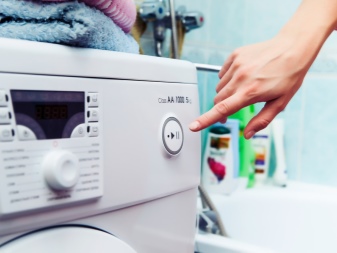Error F9 in the ATLANT washing machine: description, causes and remedies

Like any home appliance, Atlant washing machines are prone to malfunctions of one kind or another. The Belarusian manufacturer strives to minimize them by purchasing high-quality components. Many consumers who have purchased the unit note that it effectively copes with its functions. Nevertheless, errors in his work do occur. In particular, F9.
What does the F9 error mean?
Every owner of household appliances is faced with its malfunctions, the ATLANT washing machine is no exception. Most often, users encounter the F9 error. The manufacturer took care of the consumer by equipping the equipment with an automatic diagnostic system that notifies the owner of a breakdown. If your unit does not have an electronic display, then this fault can be recognized by the lower row of indicators on the control panel. In addition to the power-on indicator, 1 and 4 lights will be on, also indicating the F9 error.
If the washing machine issued this malfunction, then most often it indicates problems with the rotation of the drum. This means that the tachogenerator could fail, the electric motor broke down, the electrical circuit between the engine and the control module was broken. This breakdown can also be a normal malfunction of the device.
The control modules of Atlant washing machines are quite sensitive to power surges, due to which the firmware of the electronic board can seriously malfunction. However, such a nuisance is not so common.


Causes
When the washing machine breaks down, it is unpleasant, but you should not immediately call the repairman. First you need to carry out an external examination, read the instructions in more detail. Fortunately, many faults can be rectified by yourself. Most often, users of a unit of a Belarusian manufacturer are faced with a small number of causes of breakdowns. To exclude a one-time failure of the control board, you should take the following steps:
- unplug the electrical cord of the equipment from the socket and wait 15–20 minutes;
- turn on the washing machine again;
- if the error disappears on the display, it means that the control module is frozen and you need to restart the system.


Another reason why the F9 error can appear is a sticky spin button. If the malfunction cannot be eliminated, this means that the breakdown lies in the mechanisms of the unit. There are several reasons for this.
- Tachogenerator malfunction. The main function of this element is to accurately count the revolutions made by the drum during the operation of the washing machine. In addition, the tachometer measures the generated voltage and sends a signal to the control unit. This task is necessary for the smooth operation of the unit, since spinning and washing are performed with different numbers of revolutions.
- Motor problems. A symptom of such a malfunction is that the body or drum of the washing machine "bites" by current, and the drum does not rotate well during washing, rinsing and spinning, or it may not rotate at all. The main reason is the leakage of current to the case or the armature is broken. In this case, it is better to replace the part completely and not to repair a separate element, since it is too expensive to change a separate unit.
- Failure of the software module and failure of the electronic circuit. The control unit is considered the "brain" of the washing machine.This item is responsible for the following functions: it “commands” the motor, water inlet valves, heating elements, pump, loading door locking device. It also processes signals from the elements of the control contact group of the hatch door lock, temperature and water level sensors.



The main symptom of a breakdown is the incorrect operation of the equipment. For example, the washing program starts, but the "spin" mode is skipped, you take out absolutely wet clothes. Washing time may be shorter than indicated in the instructions. As a rule, this malfunction does not lie in the control module itself, but in the failure of some other element of the device. If the unit breaks down, it is more often due to oxidation of the wires, or the board burns out due to a frequent voltage drop in the power grid.


Elimination
The design of the Atlant washing machine does not particularly differ from the designs of models from other manufacturers. Therefore, getting to the complex elements of the device will not be difficult. When starting the repair, assess its economic feasibility. A also observe safety rules, perform all work only on the equipment disconnected from the network.
Defective tachometer
To understand that the tachometer is out of order, first of all, you need to pay attention to how the unit works. The main "symptoms" of this malfunction:
- the rotation speed of the drum changes sharply;
- in the "spin" program, the drum rotates slowly, but should increase the speed;
- with the "wash" program, the revolutions are too frequent;
- clothes remain wet after spinning.


To fix this breakdown, you first need to make sure that the F9 error occurred due to the tachogenerator.
- Disconnect the washing machine from the mains.
- Remove the back cover of the device by unscrewing the fasteners.
- At the very bottom there is a motor that needs to be disconnected.
- After that, you need to disconnect the electrical wires from the tachometer and check the voltage resistance value at the contacts with a multimeter. The indicator should be within 60 ohms. Then measure the voltage. When you turn the engine by hand, it increases and should be 0.2 V.
- If the sensor is defective, it should be replaced. To do this, unclench the harnesses and disconnect the wires. Opening the latch, remove the protective cover and unscrew the fastening bolts. Remove the broken device and install a new device by performing the above steps in reverse order.




It happens that the tachogenerator mount looses with constant shaking. It is enough to pull it up. And also, over time, the formation of oxides on the ring and wiring of the device is possible. They must be carefully removed or damaged elements replaced.
The electric motor is damaged
To eliminate this damage, it is necessary to remove the motor for inspection purposes. You should disconnect the electrical wires from it, unscrew the bolts, and pull the engine towards you. First you need to check the condition of the brushes and mounting holders.
Brushes are an important element of movable contacts - after a certain period of time they begin to wear out, which negatively affects the work of the "heart" of the unit. Their wear can also give an error code F9. It is not difficult to determine this: they will be too short. Worn brushes must be replaced.


Important: this element must be changed in pairs, using only original parts. In this case, you will be sure that the wear will be uniform, and you will not spoil the collector lamellas.
If everything is in order with these objects, you need to check the electric motor for current leakage to the case with a multimeter. Each turn of the winding should be checked for breakdown. If all malfunctions are excluded, and the error code is still issued, you should continue the diagnosis further.
Control Module and Circuit Problems
You should start by checking the electrical communication circuit. This element is located near the engine. It is a piece with wires. Each wiring should be ringed with a multimeter several times to eliminate possible errors. Replace defective wires.
If everything is in order with the electrical network, and there are no faults, there is a need to eliminate the error in the control module. It is extremely difficult to fix this problem on your own. You will need certain knowledge and skills, since it is one of the main elements of any household appliances, complex in design, execution and functioning.


This and other codes of the ATLANT washing machine are given below.









The comment was sent successfully.